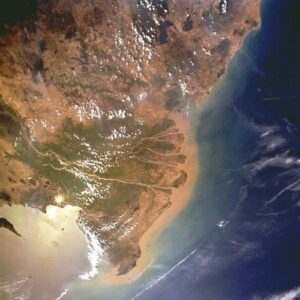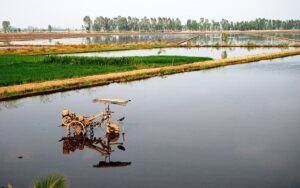The revival of coastal tree planting and catchment repair (watershed restoration) in the last 30 years offers an important lesson about the value of natural or green infrastructure and its added benefits, which include sustaining livelihoods, cultures and traditions and climate mitigation.
- Green systems such as forests, wetlands, and mangroves in conjunction with grey infrastructure could be critical to our efforts to mitigate and adapt to climate change;
- Mangrove forests are one of the best-documented examples of natural or green infrastructure, providing $250-million-worth of flood protection in coastal regions where they grow;
- Utilizing natural infrastructure and building with nature offers an innovative way to protect the future of our rivers, coasts and oceans and the communities and ecosystems they support.
In Japan, it is traditionally believed that “the forest calls the fish.” This is a more romantic way of explaining how coastal and riparian forests prevent erosion and keep agricultural run-off from reaching waterways, protecting the health and productivity of coastal fisheries.
In the Asia-Pacific region, the Developing Member Countries of the Asian Development Bank will need to invest an estimated $26 trillion in infrastructure from 2016-2030 or $1.7 trillion per year to maintain growth momentum, eradicate poverty and respond to climate change mitigation and adaptation needs. By harnessing the power of nature – using green systems such as forests, wetlands, and mangroves to complement grey infrastructure – these services can be provided at a lower cost while delivering multiple additional benefits, including climate mitigation, adaptation, disaster risk reduction and ecosystem resilience, especially in the coastal zones where most people live and businesses are based.
Mangrove forests are the best-documented example of natural or green infrastructure. Recent estimates of their economic value for flood risk reduction exceed $65 billion a year. Globally, there are more than 45 coastal stretches that benefit from $250-million-worth of annual flood protection thanks to mangroves. If lost or destroyed, 15 million more people would be flooded every year across the world.
It is not simply their ability to dampen storm surges that makes mangroves so valuable. Mangroves provide habitat and nursery areas for fish, crustaceans and mollusks; they trap sediment and pollution, sequester carbon, support climate adaptation and disaster risk reduction, and can justify lowering insurance costs.
Changing deltas
In mathematics, the Greek letter delta is the symbol for change; in nature, the changes we are seeing in river deltas are worrying. Deltas are dynamic coastal systems that are particularly vulnerable to changes in the natural processes that maintain their structure and integrity.
Asia’s six largest delta systems – Ganges Meghna-Brahmaputra, Indus, Irrawaddy, Mekong, Pearl and Yangtze – are all at risk from changes of flow. In some cases, upstream dams and impoundments and the over-extraction of sand from river and coastal areas is causing them to sink and shrink. Rich delta farmland is being lost to the sea and coastal communities are more vulnerable to storms and floods.
Utilizing natural infrastructure and building with nature will be crucial to delta and coastal resilience. Restoring fluvial and coastal sediment flows, creating more room for rivers and reconnecting floodplains, mudflats, mangroves and other wetlands have proven to be successful strategies to mitigate the effects of climate change – both floods and droughts.
Innovative development approaches are demonstrating that green and grey infrastructure can sit side-by-side. Urban-adjacent wetlands create “sponge cities” to compensate for expanding areas of impermeable concrete. This hybrid approach to infrastructure, if applied across the river basins, could transform the future of these deltas.
There is no doubt that COVID-19 economic recovery and stimulus packages will fuel infrastructure projects. In the rush for relief, we must not miss the opportunity to build back better, generate jobs, stimulate the economy, support clean energy transformations, deliver increased climate mitigation and adaptation, while supporting the natural systems that sustain us. The recent Blue Paper, Coastal Infrastructure: Resilience, Restoration and Infrastructure Requirements, provides an inventory of coastal habitat types. It includes examples where natural or hybrid infrastructure can play a significant role in natural hazard risk reduction and a framework for considering natural infrastructure in the context of coastal development, climate impacts and disaster risk reduction.
Where do we go from here?
In the last 30-50 years, there have been significant, and in many cases abrupt and irreversible, changes across all of the world’s coastal ecosystems. These have included erosion of coastlines; loss of coastal vegetated ecosystems (50% of salt marshes, 35% of mangroves), coral (30%) and shellfish reefs (85%); and the significant reduction in system resilience. Under business as usual, the rate of loss of these ecosystems is expected to continue.
The geological record and the carbon cycle show us that oceans and coasts, their layers of sediment and the web of life they support, are the planet’s primary mechanism for storing carbon. Yet this vital function in our race to bend the curve of carbon emissions rarely features as prominently as it should.
The UN Decade of Ocean Science for Sustainable Development (2021-2030) allows us to shine a spotlight on the value of ocean ecosystems and environments from a carbon perspective, equipping policy-makers with powerful arguments for their protection and restoration. Our blue forests and blue gardens need to be cultivated as part of an Ocean-Climate-Food solution. Meanwhile, our deltas and muddy and sandy sediments need to be protected from disturbance and development so their role as the sticky-paper on which carbon is captured and buried can be optimized.
Maybe you have heard the ancient saying: “The best time to plant a tree is 20 years ago. The next best time is now.” The wisdom of that sentiment must guide our decisions in this crucial moment. Whether as scientists, finance institutions, industries or civil society, we all have a critical role to help governments and policy-makers realize the many benefits of natural solutions and healthy oceans and coasts.
Let’s use this wave of economic stimulus, not to further erode the resilience of coasts and coastal communities, but rather to create coastal infrastructure that builds community resilience, supports climate mitigation, restores coastal integrity and powers a green and just economic recovery.
Featured photo by Free-Photos from Pixabay
This article by Ghislaine Llewellyn, Deputy Leader, Oceans, WWF International first appeared on the World Economic Forum website. Reprinted here (with minor edits) by permission.



